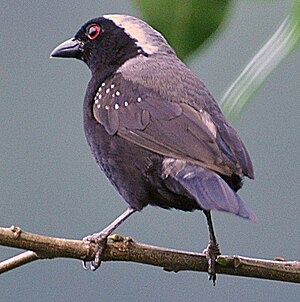Gray Neck Blackling
| Gray Neck Blackling | ||||||||||||
|---|---|---|---|---|---|---|---|---|---|---|---|---|

Gray Neck Blackling ( Nigrita canicapillus ) |
||||||||||||
| Systematics | ||||||||||||
|
||||||||||||
| Scientific name | ||||||||||||
| Nigrita canicapillus | ||||||||||||
| ( Strickland , 1841) |
The gray-necked blackling ( Nigrita canicapillus , syn .: Nigrita canicapilla ) is an African species of bird in the finch family (Estrildidae). It is a dark, forest-dwelling bird with a gray skull, a black forehead and brightly spotted wings. Several subspecies are distinguished.
The IUCN classifies the gray neck blackling as not endangered ( least concern ).
description
Gray neck blacklings reach a body length of 13 to 14 centimeters. They have a black and gray beak, a black face mask, and a light gray neck. The feathers are otherwise dark gray. The outer shoulder feathers, the large wing covers and the inner arm wings are spotted white to gray. The rump is whitish-gray and lighter than the back. In some individuals it is occasionally darkly spotted and banded. Females and males are alike, but females have more delicate bills. The beak is black, the eyes are red, the legs are dark brown to blackish.
Fledglings are uniformly dark gray with pale gray eyes.
The gray- necked blackling can be confused with the pale-forehead blackened . The gray-necked blackling, however, has a black forehead and the pale-necked blackling lacks the white dots on the wings that are characteristic of the gray-necked blackling.
Distribution area and habitat
Gray-necked blacklings are widespread from Sierra Leone to Kenya and in a southerly direction to Angola . The species occurs in lightly forested areas. It has also opened up cultivated land and occurs, for example, in coffee and cocoa plantations, in gardens or in the bushes at roadsides. In Liberia there are three to five couples per square kilometer in forest areas; in more open areas there are even three to nine pairs. Similar figures were found for Gabon . As a rule, gray-necked blacklings are observed individually or in pairs, but they are usually difficult to spot due to their plumage. Their singing is usually the first clue that gray neck blacklings are nearby. In East Africa they are at altitudes of up to 2,100 meters and in the area of the Virunga volcanoes even up to 2,600 meters. In the forests of Liberia there are three to five breeding pairs and in the forests of Gabon there are five to six breeding pairs per square kilometer.
Way of life
Gray neck blacklings live in pairs or in small family groups. Mostly gray-necked blacklings can be found in the upper treetops. They can often be seen in the company of nectar birds . Their diet consists primarily of insects such as larvae and small caterpillars, as well as ants and termites . In addition, they also eat small seeds and peels of the oil palm fruits .
Gray neck blacklings are free breeders who build their large spherical nests in bushes. They use coconut and sisal fibers, grass, moss, other plants and animal wool as building material. The female lays four to six eggs, which are incubated for twelve to 13 days. The breeding season varies depending on the distribution area. In some regions, for example in Tanzania , where clutches have only been found in January, gray-necked blackbirds only breed in a few months. In Kenya and the Democratic Republic of the Congo, gray-necked blackbirds breed all year round.
Subspecies
In addition to the nominate form first placed in the genus Aethiops , there are five other subspecies
- Nigrita canicapillus emiliae Sharpe , 1869
- Nigrita canicapillus schistaceus Sharpe, 1891
- Nigrita canicapillus diabolicus ( Reichenow & Neumann , 1895)
- Nigrita canicapillus angolensis Bannerman , 1921
- Nigrita canicapillus candidus Moreau , 1942
and an invalid subspecies has been described with the noun nudum Nigrita canicapillus sparsimgutatus .
attitude
The first gray-necked blacklings were kept at London Zoo in the early 1930s . Further imports to Great Britain took place in 1948 and 1965. It was not until 1973 that gray neck blacks were imported into Switzerland , Austria and Germany . Experienced keepers can now satisfy the birds' need for a varied diet of insects. Nevertheless, the offspring is very rare.
supporting documents
literature
- C. Hilary Fry , Stuart Keith (Eds.): The Birds of Africa. Volume 7, Christopher Helm, London 2004, ISBN 0-7136-6531-9 .
- Jürgen Nicolai (Ed.), Joachim Steinbacher (Ed.), Renate van den Elzen, Gerhard Hofmann, Claudia Mettke-Hofmann: Prachtfinken - Afrika. Series Handbuch der Vogelpflege, Eugen Ulmer Verlag, Stuttgart 2007, ISBN 978-3-8001-4964-3 .
Web links
- Videos, photos and sound recordings of Nigrita canicapilla in the Internet Bird Collection
- Gray neck blackling on AVIBASE
- BirdLife factsheet on gray neck blacks
- Nigrita canicapillus inthe IUCN 2013 Red List of Threatened Species . Listed by: BirdLife International, 2012. Retrieved November 24, 2013.